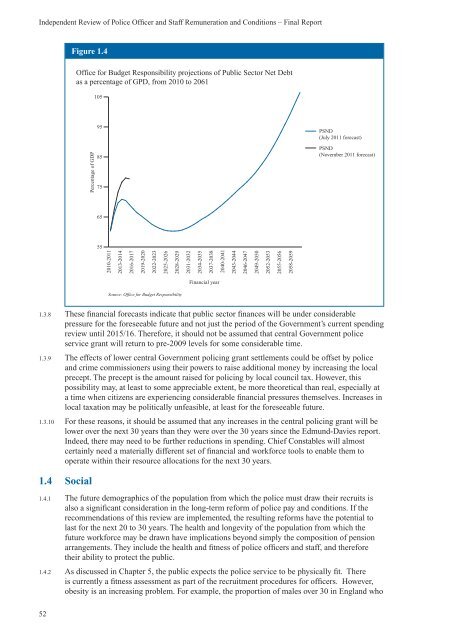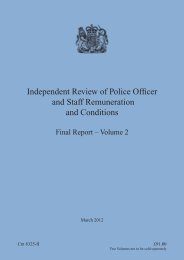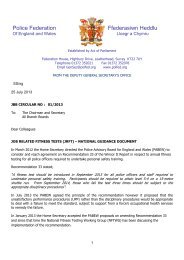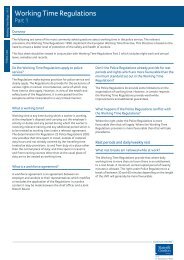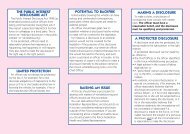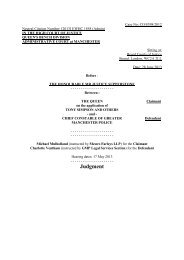- Page 6 and 7: ContentsVolume 1Acknowledgements 9F
- Page 8 and 9: AcknowledgementsAcknowledgementsThi
- Page 10 and 11: Independent Review of Police Office
- Page 12 and 13: SummarySummaryThe future challenges
- Page 14 and 15: Summarywebsite. In addition, the re
- Page 16 and 17: SummaryFigure S.2In-year change to
- Page 18 and 19: SummaryHealth, fitness and managing
- Page 20 and 21: SummaryTable S.1: Recommended const
- Page 22 and 23: SummaryNegotiating machinery32 The
- Page 24 and 25: Independent Review of Police Office
- Page 26 and 27: Independent Review of Police Office
- Page 28 and 29: Independent Review of Police Office
- Page 30 and 31: Independent Review of Police Office
- Page 32 and 33: Independent Review of Police Office
- Page 34 and 35: Independent Review of Police Office
- Page 36 and 37: Independent Review of Police Office
- Page 38 and 39: Independent Review of Police Office
- Page 40 and 41: Independent Review of Police Office
- Page 42 and 43: Independent Review of Police Office
- Page 44 and 45: Independent Review of Police Office
- Page 46 and 47: Independent Review of Police Office
- Page 50 and 51: Independent Review of Police Office
- Page 52 and 53: 2 Employment Framework2 Employment
- Page 54 and 55: 2 Employment FrameworkMetropolitan
- Page 56 and 57: 2 Employment Framework2.1.30 ACPO b
- Page 58 and 59: 2 Employment Frameworkof the over-a
- Page 60 and 61: 2 Employment Framework2.1.58 The Co
- Page 62 and 63: 2 Employment Frameworkregions or po
- Page 64 and 65: 3 Entry routes for police officers3
- Page 66 and 67: 3 Entry routes for police officers3
- Page 68 and 69: 3 Entry routes for police officers3
- Page 70 and 71: 3 Entry routes for police officersf
- Page 72 and 73: 3 Entry routes for police officerso
- Page 74 and 75: 3 Entry routes for police officersT
- Page 76 and 77: 3 Entry routes for police officersa
- Page 78 and 79: 3 Entry routes for police officersc
- Page 80 and 81: 3 Entry routes for police officersF
- Page 82 and 83: 3 Entry routes for police officers3
- Page 84 and 85: 3 Entry routes for police officersp
- Page 86 and 87: 3 Entry routes for police officersR
- Page 88 and 89: 3 Entry routes for police officers3
- Page 90 and 91: 3 Entry routes for police officerst
- Page 92 and 93: 3 Entry routes for police officersS
- Page 94 and 95: 3 Entry routes for police officersT
- Page 96 and 97: 3 Entry routes for police officersR
- Page 98 and 99:
3 Entry routes for police officersa
- Page 100 and 101:
3 Entry routes for police officersi
- Page 102 and 103:
3 Entry routes for police officersi
- Page 104 and 105:
3 Entry routes for police officersR
- Page 106 and 107:
3 Entry routes for police officerse
- Page 108 and 109:
3 Entry routes for police officersR
- Page 110 and 111:
3 Entry routes for police officerss
- Page 112 and 113:
3 Entry routes for police officerst
- Page 114 and 115:
3 Entry routes for police officersa
- Page 116 and 117:
3 Entry routes for police officersc
- Page 118 and 119:
3 Entry routes for police officersa
- Page 120 and 121:
3 Entry routes for police officersF
- Page 122 and 123:
3 Entry routes for police officersT
- Page 124 and 125:
3 Entry routes for police officers3
- Page 126 and 127:
3 Entry routes for police officers3
- Page 128 and 129:
3 Entry routes for police officers3
- Page 130 and 131:
3 Entry routes for police officers3
- Page 132 and 133:
3 Entry routes for police officersF
- Page 134 and 135:
3 Entry routes for police officersO
- Page 136 and 137:
3 Entry routes for police officersm
- Page 138 and 139:
3 Entry routes for police officerse
- Page 140 and 141:
3 Entry routes for police officersR
- Page 142 and 143:
3 Entry routes for police officersa
- Page 144 and 145:
3 Entry routes for police officersF
- Page 146 and 147:
3 Entry routes for police officersC
- Page 148 and 149:
3 Entry routes for police officersc
- Page 150 and 151:
3 Entry routes for police officersd
- Page 152 and 153:
3 Entry routes for police officersR
- Page 154 and 155:
3 Entry routes for police officers3
- Page 156 and 157:
3 Entry routes for police officersT
- Page 158 and 159:
3 Entry routes for police officers3
- Page 160 and 161:
3 Entry routes for police officerss
- Page 162 and 163:
3 Entry routes for police officers3
- Page 164 and 165:
3 Entry routes for police officerse
- Page 166 and 167:
3 Entry routes for police officersi
- Page 168 and 169:
3 Entry routes for police officerss
- Page 170 and 171:
3 Entry routes for police officersc
- Page 172 and 173:
3 Entry routes for police officersn
- Page 174 and 175:
3 Entry routes for police officersC
- Page 176 and 177:
3 Entry routes for police officersw
- Page 178 and 179:
3 Entry routes for police officers3
- Page 180 and 181:
3 Entry routes for police officersT
- Page 182 and 183:
3 Entry routes for police officersT
- Page 184 and 185:
3 Entry routes for police officersB
- Page 186 and 187:
3 Entry routes for police officerss
- Page 188 and 189:
3 Entry routes for police officersR
- Page 190 and 191:
3 Entry routes for police officers
- Page 192 and 193:
Independent Review of Police Office
- Page 194 and 195:
Independent Review of Police Office
- Page 196 and 197:
Independent Review of Police Office
- Page 198 and 199:
Independent Review of Police Office
- Page 200 and 201:
Independent Review of Police Office
- Page 202 and 203:
Independent Review of Police Office
- Page 204 and 205:
Independent Review of Police Office
- Page 206 and 207:
Independent Review of Police Office
- Page 208 and 209:
Independent Review of Police Office
- Page 210 and 211:
Independent Review of Police Office
- Page 212 and 213:
Independent Review of Police Office
- Page 214 and 215:
Independent Review of Police Office
- Page 216 and 217:
Independent Review of Police Office
- Page 218 and 219:
Independent Review of Police Office
- Page 220 and 221:
Independent Review of Police Office
- Page 222 and 223:
Independent Review of Police Office
- Page 224 and 225:
Independent Review of Police Office
- Page 226 and 227:
Independent Review of Police Office
- Page 228 and 229:
Independent Review of Police Office
- Page 230 and 231:
Independent Review of Police Office
- Page 232 and 233:
Independent Review of Police Office
- Page 234 and 235:
Independent Review of Police Office
- Page 236 and 237:
Independent Review of Police Office
- Page 238 and 239:
Independent Review of Police Office
- Page 240 and 241:
Independent Review of Police Office
- Page 242 and 243:
Independent Review of Police Office
- Page 244 and 245:
Independent Review of Police Office
- Page 246 and 247:
Independent Review of Police Office
- Page 248 and 249:
Independent Review of Police Office
- Page 250 and 251:
Independent Review of Police Office
- Page 252 and 253:
Independent Review of Police Office
- Page 254 and 255:
Independent Review of Police Office
- Page 256 and 257:
Independent Review of Police Office
- Page 258 and 259:
Independent Review of Police Office
- Page 260 and 261:
Independent Review of Police Office
- Page 262 and 263:
Independent Review of Police Office
- Page 264 and 265:
Independent Review of Police Office
- Page 266 and 267:
Independent Review of Police Office
- Page 268 and 269:
Independent Review of Police Office
- Page 270 and 271:
Independent Review of Police Office
- Page 272 and 273:
Independent Review of Police Office
- Page 274 and 275:
Independent Review of Police Office
- Page 276 and 277:
Independent Review of Police Office
- Page 278 and 279:
Independent Review of Police Office
- Page 280 and 281:
Independent Review of Police Office
- Page 282 and 283:
Independent Review of Police Office
- Page 284 and 285:
Independent Review of Police Office
- Page 286 and 287:
Independent Review of Police Office
- Page 288 and 289:
Independent Review of Police Office
- Page 290 and 291:
Independent Review of Police Office
- Page 292 and 293:
Independent Review of Police Office
- Page 294 and 295:
Independent Review of Police Office
- Page 296 and 297:
Independent Review of Police Office
- Page 298 and 299:
Independent Review of Police Office
- Page 300 and 301:
Independent Review of Police Office
- Page 302 and 303:
Independent Review of Police Office
- Page 304 and 305:
Independent Review of Police Office
- Page 306 and 307:
Independent Review of Police Office
- Page 308 and 309:
Independent Review of Police Office
- Page 310 and 311:
Independent Review of Police Office
- Page 312 and 313:
Independent Review of Police Office
- Page 314 and 315:
Independent Review of Police Office
- Page 316 and 317:
Independent Review of Police Office
- Page 318:
Published by TSO (The Stationery Of


